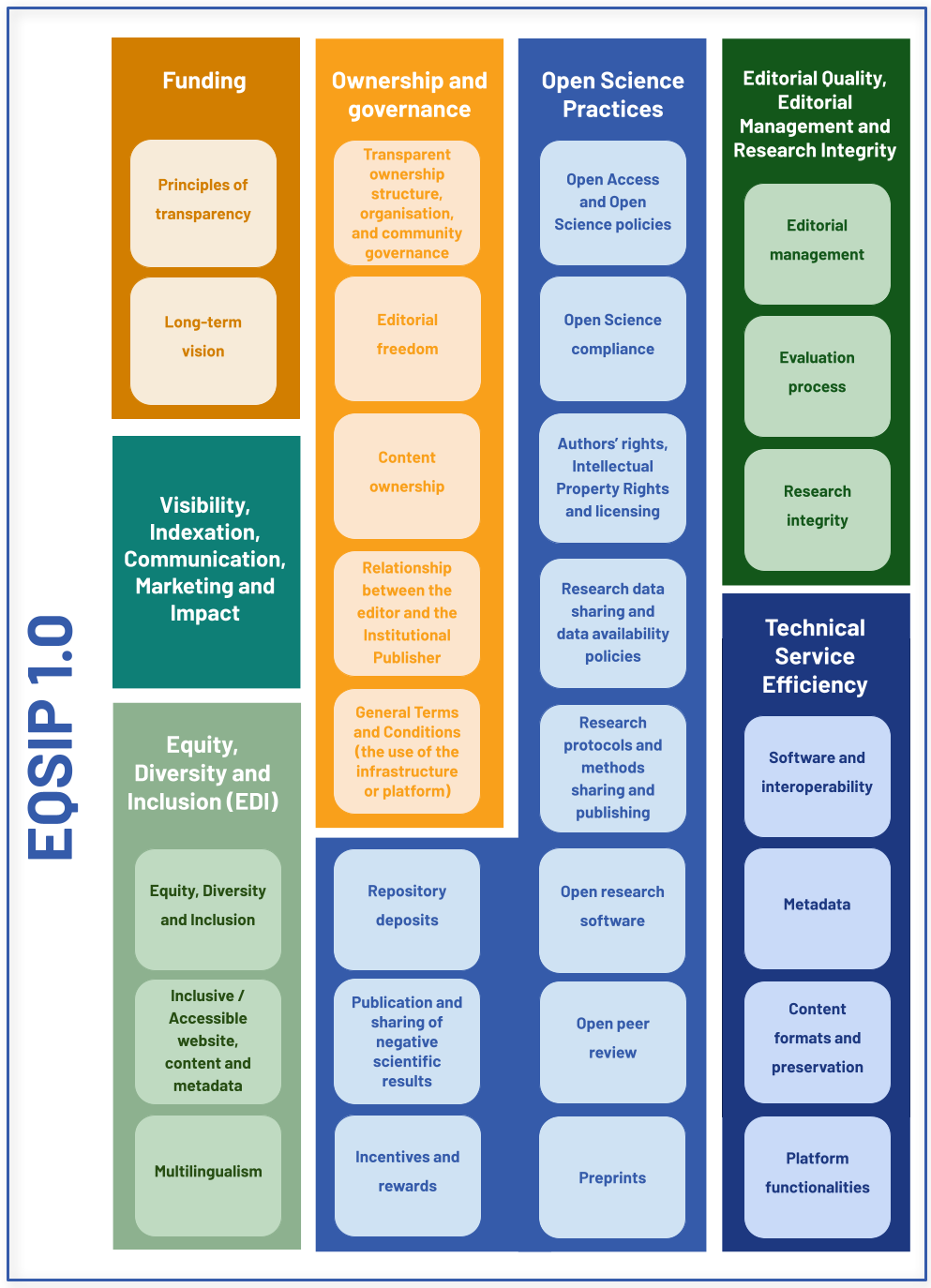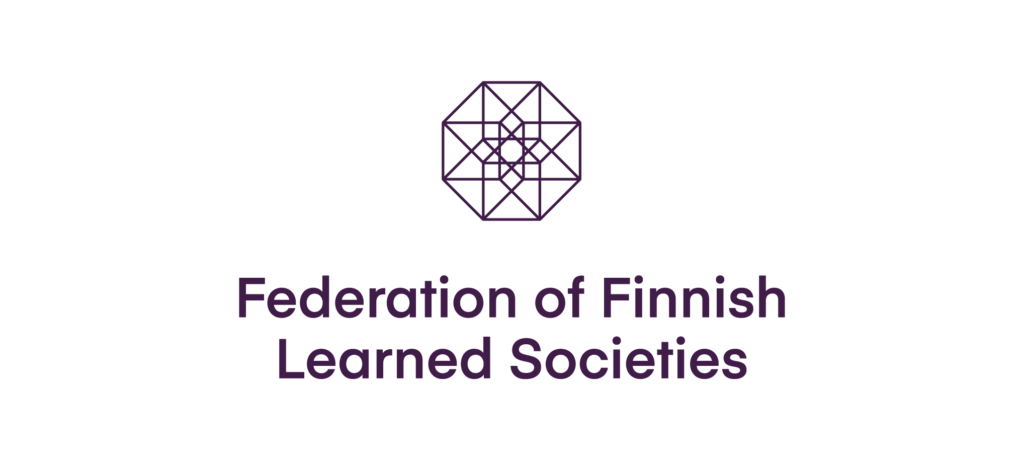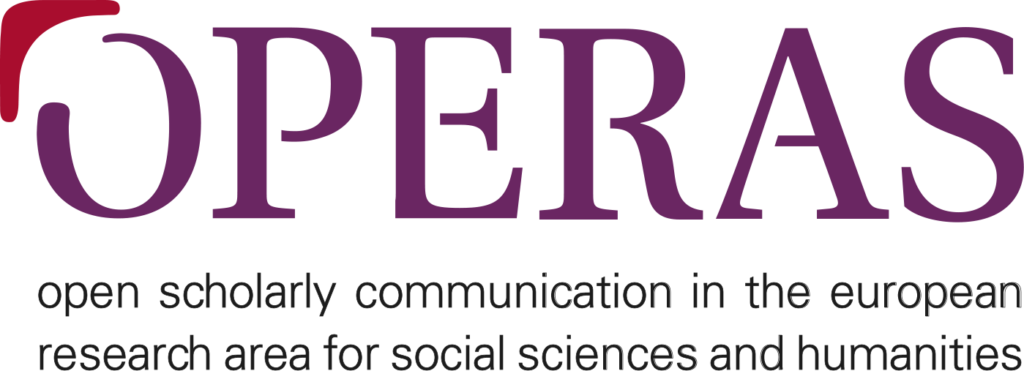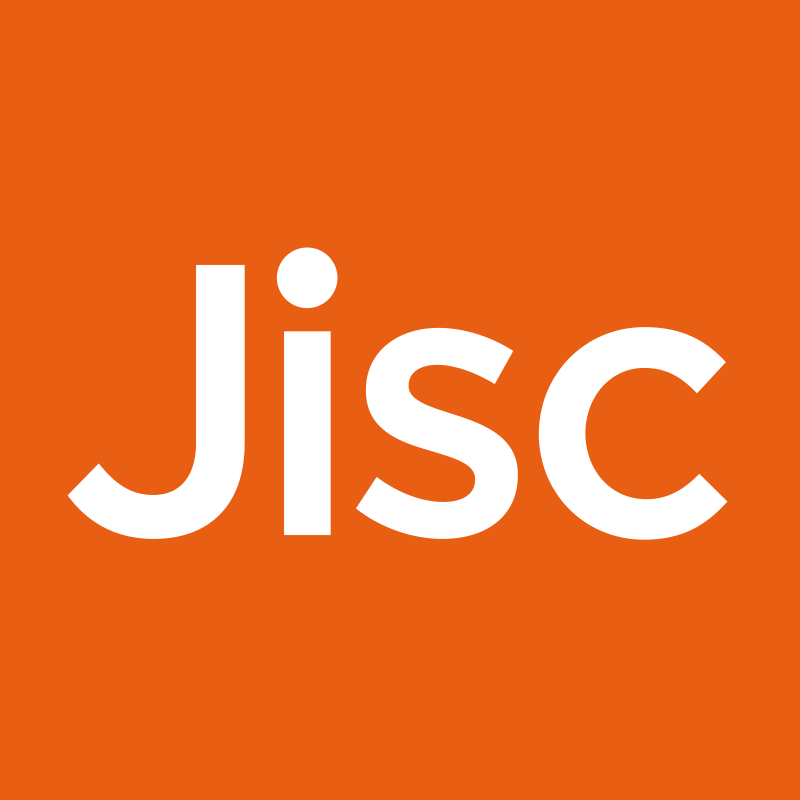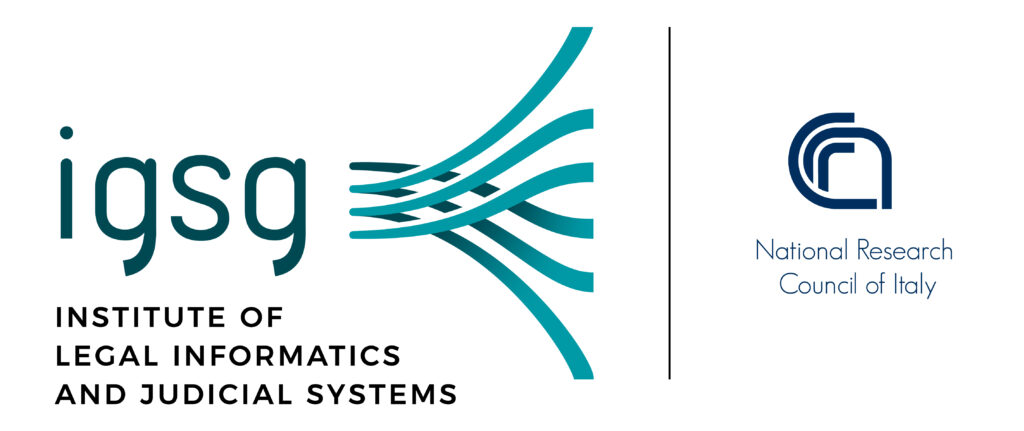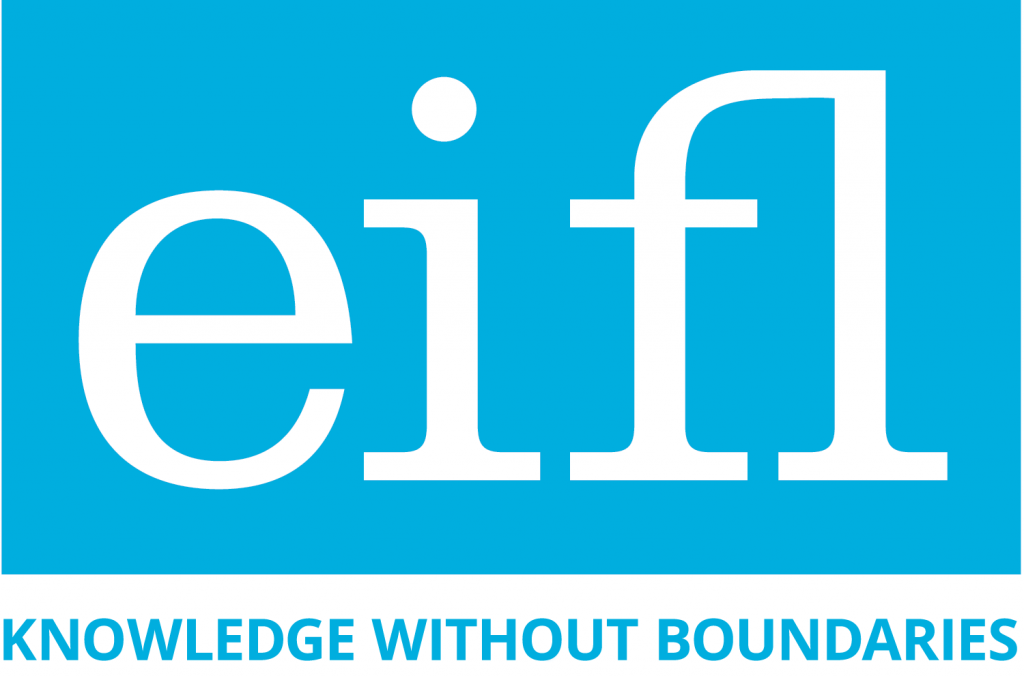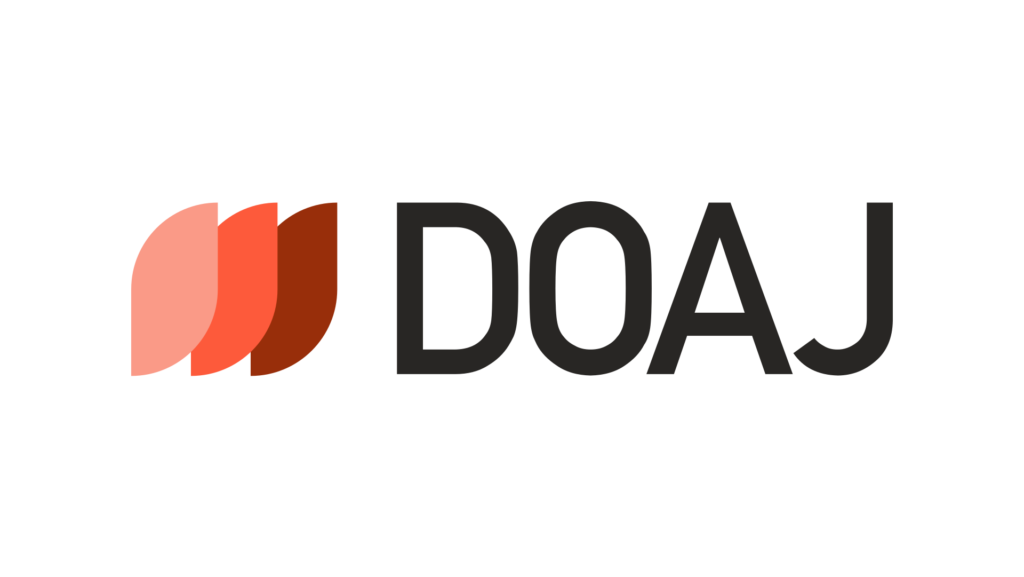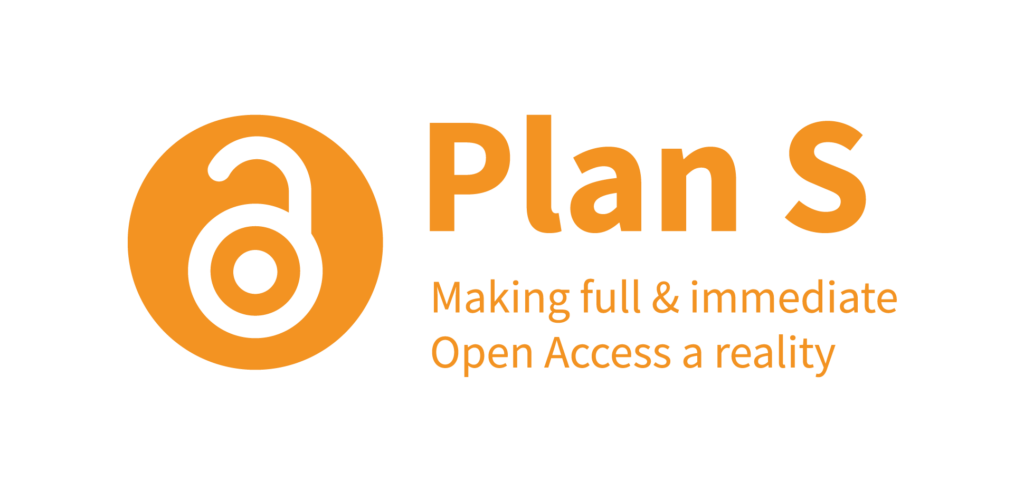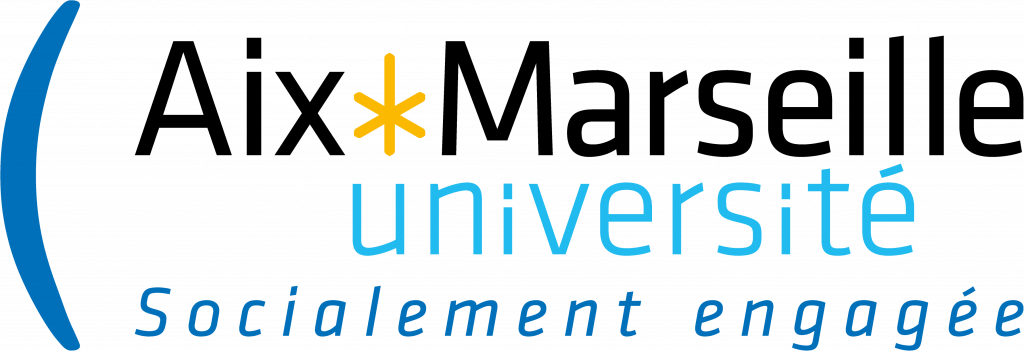Clara Armengou1, Tabea Klaus2, Iryna Kuchma3, Iva Melinščak Zlodi4, Jadranka Stojanovski5, Milica Ševkušić3, Andrej Vrčon6
1 DOAJ (Directory of Open Access Journals), United Kingdom
2 Goettingen State and University Library, Germany
3 EIFL, Lithuania
4 University of Zagreb Faculty of Humanities and Social Sciences, Croatia
5 University of Zadar, Croatia
6 LIBER, The Netherlands
POSTER
OAI13 The Geneva Workshop on Innovations in Scholarly Communication, 4-8 September 2023
Funded by the European Union under Grant agreement ID: 101058007 (DIAMAS) and Grant agreement ID: 101094397 (CRAFT-OA)
This work is licensed under a Creative Commons Attribution 4.0 International License
The Extensible Quality Standard for Institutional Publishing (EQSIP), developed by DIAMAS, seeks to ensure the quality and transparency of governance, processes and workflows in institutional publishing and addresses the seven core components of scholarly publishing outlined in the Diamond OA Action Plan, which were subsequently revised and modified by the DIAMAS project team (Quality evaluation criteria, best practices, and assessment systems for Institutional Publishing Service Providers (IPSPs) https://doi.org/10.5281/zenodo.7859172).
The EQSIP is being developed in two stages: the first version, EQSIP 1.0 presented in this poster, is based on an analysis of the existing standards, best practices, evaluation criteria, guidelines and recommendations which have been identified as relevant for institutional publishers. EQSIP 1.0 is aspirational: it represents an attempt at outlining what we believe is an ideal quality level that Diamond OA IPSPs would adhere to. This emphatically does not imply that Diamond OA IPSPs are currently expected to conform to this standard. EQSIP 1.0 should be seen as an aspirational gold standard for IPSPs, but also as a pathway for building future tools, aids and guidelines that will help academic journals and publishers to achieve this goal.
EQSIP 1.0 will be further tested with a representative sample of IPSPs and the results of the testing will be used to develop EQSIP 2.0 versions that are best suited for specific scholarly disciplines, regions, and languages. The various versions of EQSIP 2.0 will only be fully implemented once all the necessary infrastructure for supporting Diamond OA IPSPs is in place.
PALOMERA, CRAFT-OA and other projects supporting Diamond OA will help DIAMAS in EQSIP testing and dissemination.
Read EQSIP 1.0 and provide you feedback in the form below.
The Extensible Quality Standard for Institutional Publishing (EQSIP)
4 Editorial Quality, Editorial Management and Research Integrity
5 Technical Service Efficiency
6 Visibility, Indexation, Communication, Marketing and Impact
7 Equity, Diversity and Inclusion (EDI): Multilingualism, Gender Equity
1 Funding
Principles of transparency
- Clear OA policy that covers the Diamond OA business model and compliance with funder and/or institutional or national OA policies (if they exist).
- Transparency about the types of revenue streams and their destination (donations are possible, e.g. Voluntary Author Contributions (VAC) can be considered as an optional revenue stream).
- Consistent workflows allowing authors, editors and reviewers to disclose financial conflicts of interest (in the Conflict of Interest statement and the metadata) and disclose all sources of funding (in the Funding acknowledgements /statements and the metadata).
- Editorial operations are independent and free from influence from the bodies that financially support IPSPs.
- Formal, explicit, written policies for advertising in both print and digital versions and for accepting other types of funding.
Long-term vision
- Sustainability plan, i.e. a strategy for the medium-term economic viability described on the website; and/or describing OA sustainability through cooperative work schemes and costs shared across actors.
- Funded by long-term sustainable financial support from academic institutions and public organisations that have either performing research or funding it as their goal. Contributions are not tied to individual outputs or groups of authors.
2 Ownership and Governance
Transparent ownership structure, organisation, and community governance
- Transparent ownership structure, controlled by and responsive to the scholarly community (e.g. a controlling scholarly organisation, not a commercial publisher, owns the journal title, so that a change of the service provider can be achieved without changing the title).
- Transparent indication of the various service providers who are responsible for distinct technical and non-technical aspects of the workflow (e.g. ownership of infrastructure, copy-editing and typesetting services used, etc).
- Alignment with the DINI certificate for OA Publication Services (incl. journals) (https://doi.org/10.18452/21759 / https://edoc.hu-berlin.de/handle/18452/22465), Version 2019 that demands information on Visibility of the Service, Guidelines (Policy), Support of Authors and Publishers, Legal Aspects, Information Security, Indexing and Interfaces, Long-Term Archiving.
- Strategic governance that allows community input on the direction of the publishing service and operational governance with community representation and decision making power.
- Transparent communication between the IPSP, the owner, and any publication oversight body.
- Clearly defined and publicly displayed composition and constitution of the journal’s/platform’s editorial bodies: the names of the members of the editorial team, their current functions and roles; the names of the members of the Editorial Board and their current affiliations. PIDs (such as ORCID) and links to institutional profiles are provided to unambiguously specify the identity and affiliation of individual editorial Team and Board members.
- Openly available procedures for the selection of members of governance and editorial bodies together with details of a regular renewal process. Clearly defined procedures are in place for the dissolution of the board, the closure of the journal, and the transfer and preservation of its assets.
Editorial freedom
Editors-in-chief and/or Editorial Teams have full authority over the entire editorial content of their journal and the publication timing of that content.
Content ownership
- Reviewers retain copyright of their reviews, and editorial bodies and institutions retain ownership of all correspondence and mailing lists compiled on the electronic submission system put at their disposal by the publisher (if commercial publishers are involved).
- Authors retain rights without restriction, including Intellectual Property Rights (IPR).
- A publishing agreement, or terms of use, describes the content ownership and reuse rights.
The editorial team and the Institutional Publishermeet regularly to discuss political, commercial, or other incidents that could impair the scientific credibility of the publication and agree to collaboratively take measures necessary to ensure that such incidents do not affect the decisions of the editor.
General Terms and Conditions of the use of the infrastructure or platform
The General Terms and Conditions of the use of the infrastructure or platform are publicly displayed.
3 Open Science Practices
Open Access and Open Science policies
A defined statement on OA and Open Science (OS) and how publishing services support them is publicly available, which includes the elements below:
Open Science compliance
All articles and not only their metadata contain all necessary information of the article in human as well as machine-readable form.
Authors’ rights, Intellectual Property Rights and licensing
IPSPs provide their users with complete and reliable information about the terms of use of IPSPs’ content and services. Users’ rights, conditions of reuse and redistribution of content are clearly described and labelled in human and computer-readable form, using standardised systems of open licences and rights statements.
Authors retain moral and exploitation rights, and contributions are published under a Creative Commons (CC) licence (preferably CC-BY) to ensure further reuse without restrictions.
Research data sharing and data availability policies
IPSPs have an output-level policy on data availability. They encourage the use of reporting guidelines, the registration of clinical trials and other study designs according to standard practice in their discipline. Data underlying publications are available to editors and reviewers when the manuscript is submitted for review, and to all others by the time of publication at the latest. Data are made available in trusted repositories under FAIR principles with publicly available metadata. For a sustainable connection between article and data the linking through PIDs is key. The PID connection should be in both directions (from the article to the data and from the data to the article). Exceptions to data sharing are justified when it comes to personal and sensitive data, when no consent has been obtained for sharing, for reasons of protection of intellectual property, or to avoid revealing endangered areas, groups or species. In these cases, it is possible to share the data in an anonymised manner, or under conditions of controlled and regulated access. Exceptions and specifics for access to data are explained by the author in the accompanying Data Availability Statement and publicly available metadata.
Research protocols and methods sharing and publishing
IPSPs have output-level policies that make associated research protocols and methods available, with PIDS making the relevant connections. This is a good open science practice that allows others to replicate and build on published work.
Open research software
IPSPs encourage the sharing of research software in a similar way to research data. As part of their policy in making available any material underpinning published research results, IPSPs ask for a software and code availability statement. Authors are expected to provide access to software and make code available in suitable repositories to enable reproducibility by facilitating access and reuse.
Open peer review
Open Peer Review is the preferred practice of OS. It aims to improve the reviewing system through a more collaborative mindset, and opens up the complete scholarly discussion rather than just making accessible the results of that discussion.
Editorial teams will consider encouraging open reviewing policies that are in line with the NISO Peer Review Terminology Standardization guidelines. These policies and guidelines ideally provide reviewers with the possibility of: (a) signing their reviews either with their identity only visible to the editor, author, and the other reviewers, or with their identity visible to all readers; (b) publishing either review summaries or the full content of their review reports with identities visible or not, either alongside the published article with a separate DOI or in an open preprint repository. Such policies can also allow the corresponding author to opt for publishing either review summaries or the full content of review reports of their article or chapter.
These options are offered as a way to familiarise reviewers and authors with Open Peer Review gradually, and to give them proper credit for their work. The option not to sign a review allows reviewers to manage social power differentials with authors. Publicly available reviews provide the broader research community with greater insight into the way a publication decision was reached, and how the author took the comments of the reviewers into account. Where possible, it is also recommended to publish authors’ replies to reviews and editorial decisions.
Preprints
IPSPs accept the submission of unreviewed preprints that are already available on preprint servers or in open repositories. They manage the peer review process of these papers with the understanding that there is no value in hiding the identity of authors.
Repository deposits
IPSPs allow dissemination of the preprint version of published outputs. Authors can deposit any version of the work: preprint, Author Accepted Manuscript (AAM) or Version of Record (VoR) to an open repository of the authors’ choice before or after publication. The work and its supplementary material are deposited in public repositories, through unique and persistent identifiers that should be cross referenced.
Publication and sharing of negative scientific results
In relevant disciplines, IPSPs are encouraged to post output-level editorial policies that ensure the publication of negative scientific results, or unexpected results and data that do not bear out the initial hypotheses and experimental designs of the authors. Such results also contribute to the advancement of science and scholarship. Editorial policies that allow for the publication of Registered Reports and their subsequent results can ensure the publication of negative results.
Incentives and rewards
IPSPs provide reviewers with acknowledgement letters when asked to do so. They reward reviewers by publishing an annual list of reviewers (with their consent) to thank them, and they encourage reviewers to publish their reviews in accordance with Open Peer Review policies that make the work of reviewers visible. Institutions are encouraged to treat and reward editorial work as an academic activity.
4 Editorial Quality, Editorial Management and Research Integrity
Editorial Management
The journal or book’s website (and that of the IP) clearly displays:
- Information about the journal’s/IPSP’s mission (a journal/IPSP mission statement), aims, and scope is publicly available on the website, and the languages in which manuscripts can be submitted are clearly indicated.
- Names and affiliations for all editors and editorial board members. It is important that the journal’s editorial board is composed of recognised and active experts in their field. Editor roles and responsibilities are clearly described, but at the very least, editor roles include the selection of reviewers for the papers assigned to them, providing authors with advice on how to improve their papers, and negotiating disagreements between authors and reviewers.
- Author charges. The journal provides explicit information that no (obligatory) fees are charged to the authors, or that authors who have access to institutional funding (grants, library funds) for OA fees are given the opportunity to make a Voluntary Author Contribution (VAC).
- Author guidelines, including information on:
– The journal’s or the IP’s OA policy
– Licensing policy
– Copyright / author’s rights policy
– The nature of the evaluation process used, including expected timeframe.
– Submission information (such as the article types the journal will accept, the stylesheet that contributions should adhere to and the templates or tools that should be used).
- Publishing timelines: The Institutional Publisherstates its publishing timelines or the declaration of continuous publication. The publication date declared on the publication is the actual date when the publication became available online.
- The Institutional Publisherhas a publicly displayed archival, digital preservation policy, which is consistently implemented.
- Сompliance with the GDPR and relevant regulations is clearly stated and ensured.
Evaluation process
All submitted manuscripts undergo a rigorous evaluation process before or after publication that is in line with accepted practices in the relevant discipline. This evaluation process can involve peer review, or another type of evaluation by at least one person who has no conflict of interest with the author(s). The type and details of the evaluation process are stated clearly on the website and explained in detail. Evaluation can take place before or after publication, depending on the review model adopted (pre-publication peer review, post-publication peer review (Publish, Review, Curate (PCR) models), overlay journals, etc).
Endogeny (i.e. manuscripts being reviewed by a closed circle of people who are well acquainted with each other or work in the same institution) is minimised, and the proportion of published papers where at least one of the authors is an editor, editorial board member, or reviewer does not exceed 25%.
Research integrity
The IP’s editorial policies and procedures are transparent and easy to find on the IP’s website. They cover the publication ethics adhered to (for example, COPE’s core practices or the IPSP’s own publication ethics statement), address authorship and contributorship, explain how complaints and appeals/allegations of research misconduct and conflicts of interest are handled. Also included are policies on data sharing, availability, and reproducibility, ethical oversight, intellectual property, post-publication discussions, and corrections and retractions (for further details on data sharing and intellectual property, see section 3 above: OS Practices).
The Institutional Publisheralso has a policy on chatbots and other writing assistance tools, referring to industry-agreed best practice in this area (such as COPE) to inform authors and help them understand the responsibility they have regarding the accuracy and originality of their work and the transparency of the writing process.
5 Technical Service Efficiency
A publishing platform supports online submission, editorial, and publishing workflows.
Software and interoperability
The publishing platform is based on free and open-source software, with publicly available code, while the Institutional Publisher (IP) or Service Provider (SP) (see footnote 1) uses free and open-source software as much as possible in its editorial and publishing workflows. The platform is developed and regularly updated to conform to current interoperability standards (OpenAIRE Guidelines, KBART, COUNTER), accessibility guidelines (e.g. W3C Web Content Accessibility Guidelines – WCAG) and open science principles.
The publishing platform supports widely adopted metadata formats for harvesting (e.g. Dublin Core, OpenAIRE, etc.) and metadata exchange protocols (OAI-PMH, APIs), and indicates which interoperability protocols are used and how to access them. It also supports massive metadata export (as CSV files, ONIX XML feeds or in any other established format) and provides metadata records to libraries (e.g.MARC).
Text and data mining (automatic downloading, extraction and indexing of the full texts and the associated metadata) is supported and this is stated in the relevant policy.
Metadata
Each published item (article, chapter, book, etc.) has a dedicated unique URL (landing page) and persistent identifier (preferably DOI).
The following metadata are provided for each published item, in human- and machine-readable formats (e.g. HTML meta tags, XML exposed via OAI-PMH, JSON and other formats downloadable from the landing page, etc.):
- title,
- full names and institutional affiliations – including country/region – of all contributing authors,
- abstracts and keywords,
- funding information (as a minimum the name of the funder and the grant number/identifier). LOCKS
Standard numbers (ISSN, eISSN, ISBN, ISMN etc.) and other persistent identifiers for the publication (DOI), authors and contributors (ORCID), author affiliations (ROR), and funding organisations (Funder DOIs), as well as other relevant persistent identifiers, are provided in human- and machine-readable formats.
CRediT tags are used to indicate contributions of the authors (coded in JATS xml).
Conflict-of-interest statements within publications are captured in the metadata using JATS XML.
Human- and machine-readable information about the open access status, copyright holder and licensing is provided in each publication in a standard non-proprietary format.
Complete metadata about publications, including bibliographic references, are regularly deposited in a registration agency (e.g. CrossRef) in line with the Initiative for Open Citations (I4OC) and Initiative for Open Abstracts (I4OA).
There is an established protocol for the transfer of metadata to open access repositories and content aggregators.
Content formats and preservation
Full-text content is tagged in the XML JATS or equivalent (e.g. TEI) format and provided in multiple digital formats (PDF, HTML, XML, ePub, etc.), at least one of which is suitable for preservation. The published content is deposited in a digital preservation service (LOCKSS, CLOCKSS, Portico, Internet Archive, national libraries and other public preservation services etc.).
Publications hosted on the platform contain high resolution figures and well-constructed tables, annotated and easy to read and interpret, and provide links to data, code, and other research outputs that underlie the publications and are available in external repositories.
Platform functionalities
The publishing platform has basic functionalities (searching, browsing, navigation) and a user-friendly interface adjusted to a low bandwidth. It also enables alerting services, sharing to social networks, post-publication evaluation and commenting, support for multimedia and open peer review (where relevant). Tables of contents or structures that allow direct access to articles/chapters in as few clicks as possible are provided.
The publishing infrastructure is well maintained, updated, regularly backed up and protected from viruses and malware, and it is also supplied with user instructions and documentation for editorial staff and end users.
6 Visibility, Indexation, Communication, Marketing and Impact
IPSPs provide unhindered and reliable communication and dissemination of content to academia and society at large. Content dissemination is closely related to the technical aspects of interoperability (metadata standards, exchange protocols, etc.) and Open Science practices (open metadata, licences). The use of social media and social networking, collaboration with the media and the use of traditional and modern dissemination methods, help spread the content to a broader audience.
- All information provided on the website is accurate, reliable, regularly updated and not misleading in any way.
- The community of users is regularly informed (e.g. through newsletters, blogs, social media, direct emails, mailing lists, content alerts, notifications, RSS/Atom feed or other mechanism) of developments, policy changes, updates, new features and functionalities, as well as about new publications. Active use and regular updates of social media or social networking help to reach out to academia and society.
- IPSPs make sure that the visibility of publications in search engines (general and academic) and aggregators is improved by using search engine optimization techniques, by providing structured metadata and XML sitemaps, by implementing metadata exchange protocols, such as OAI-PMH, or by enabling APIs. The information about APIs and OAI-PMH endpoints is indicated on the website.
- IPSPs increase the visibility of the published content by applying for inclusion to discovery services, aggregator databases, abstraction and indexing databases, and citation indexes.
- IPSPs encourage authors to make the published content available in open repositories and sharing services in order to increase its visibility.
- IPSPs support publishing impact statements or simple (multi)language summaries alongside published content to bring the content of scholarly publications closer to the general audience.
- IPSPs support the promotion of published content (e.g. by inviting post-publication reviews of outputs, inviting and moderating post-publication online comments, organising events like book promotions, sending out copies, writing press releases, working with the media) in order to reach broader sectors of society.
- IPSPs engage in appropriate and well-targeted marketing activities (including solicitation of manuscripts for their publications) .
- IPSPs provide metric indicators that are an important source of information about content usage. The following information is useful and interesting for users:
a) article/chapter-level metrics, such as visits, views, downloads, citations,
b) publication-level metrics,
c) altmetrics indicators,
e) geographical spread of visitors,
f) analytics software and methods used to generate and collect metrics.
7 Equity, Diversity and Inclusion (EDI): Multilingualism, Gender Equity
IPSPs raise awareness among authors, members of editorial boards (and any supporting committees), peer reviewers, journal staff for the diversity and pluralism of the stakeholders’ linguistic, cultural, academic, geographical, institutional, economic backgrounds, and accessibility.
Equity, Diversity and Inclusion
IPSPs and/or journals display the following policies on their websites:
- Policy statement that submissions within the thematic scope and language of the journal are accepted from all potential authors and that decision-making concerning content is without regard to their race, gender, age, sexual orientation, religious belief, ethnic origin, citizenship, or the political philosophy.
- Policy on bias-free language related to age, disability, gender, racial and ethnic identity, sexual orientation, and socioeconomic status in all communications.
- Policy requiring authors to inform whether the research data are sensitive to age, disability status, sex, gender identity, racial and ethnic identity, sexual orientation, and /or socioeconomic status.
- Equity, Diversity and Inclusion (EDI) guidelines setting principles, commitments and actions for promoting diversity in terms of linguistic, cultural, academic, geographical, institutional, economic backgrounds and disabilities.
- Gender Equity Plan (GEP) regarding the composition of editorial staff and boards, policies that strive for gender balance among peer reviewers, and a set of commitments and actions that aim to promote gender equality, all publicly available on the website.
IPSPs and/or journals also:
- Set a goal to increase stakeholder representation based on gender identity, race/ethnicity, disability status, and country.
- Assess and monitor progress in EDI by collecting and making the following data available:
- Gender balance of editorial board members, peer-reviewers, authors, and staff.
- Proportion of editorial board members, peer-reviewers, authors, and staff by country.
- Proportion of editorial board members, peer-reviewers, and authors by organisational affiliation.
- Proportion of editorial board members, peer-reviewers, authors, and staff that are early career researchers’ (1-7 years from degree).
- Proportion of outputs authored by members of editorial bodies.
- Amount of feedback received relating to shortcomings in accessibility standards.
- Proportion of abstracts and full-texts which are multilingual.
Inclusive/Accessible website, content and metadata
IPSPs and/or journals will display the following statements on their websites:
- Accessibility statement, which is a public information page that describes organisational policies and accessibility goals, shortcomings concerning accessibility standards, and provides information on feedback channels. Accessibility statements contain at least the following:
- A commitment to accessibility for people with disabilities.
- The WCAG 2.1 accessibility standard applied.
- Contact information in case users encounter problems.
- Any known limitations, to avoid the frustration of users.
- Measures taken by the organisation to ensure accessibility.
- Technical prerequisites, such as supported web browsers.
- Environments in which the content has been tested to work.
- References to applicable national or local laws and policies.
- Accessibility of the content, with all images and tables in publications and on the website having a description for the visually impaired.
Multilingualism
IPSPs and/or journals support multilingualism by implementing any of the following measures:
- Abstracts in at least two languages, where relevant.
- Machine-translation friendly abstracts.
- Enabling abstracts and full-texts in two or more languages in the same document or as separate documents, if the authors provide translations.
- Policy allowing publishing of different language versions in another journal, if information on the first publication is also added.
- Multilingual website and content, where relevant, with a minimum of 2 languages included. The information given on the site is the same in all languages.
- Integrate machine translation tool/solution on the website where relevant.
- Metadata available in English when the language of the text is not English.
- Employ toolkits or training to address language bias in peer-review.
- Support human translation and language-check services to authors.
If the feedback form doesn’t show, click here.
Newsletter subscription: DIAMAS | CRAFT-OA
Follow us: @diamasproject | @craftoa_project
Have a closer look: diamasproject.eu | craft-oa.eu



